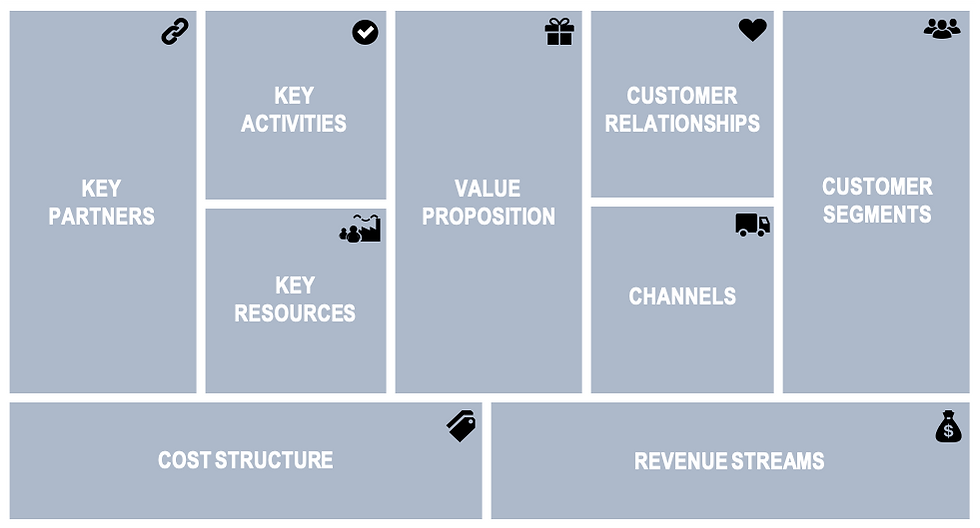Design Thinking for Commuters: How SimplyGo is Shaping Better Travel
- Allan Ung

- Jan 22, 2024
- 5 min read
Updated: Dec 22, 2025
by Allan Ung

"You've got to start with the customer experience and work back toward the technology—not the other way around."
Steve Jobs
Introduction
In the ever-evolving landscape of innovation, where user experience is paramount, methodologies like Design Thinking, Value Proposition Canvas, and Business Model Canvas have become guiding lights for businesses seeking to create meaningful and user-centric solutions. Today, we delve into the real-world case of SimplyGo, the public transport payment platform in Singapore, to understand how these methodologies could have reshaped its trajectory.
Navigating Transit Payment Systems in Singapore
1. SimplyGo
Launched by the Land Transport Authority (LTA) in March 2019, SimplyGo streamlines public transportation payments, enabling the use of contactless bank cards on buses and trains.
2. EZ-Link Cards
Widely used for public transportation payments, EZ-Link cards offer convenient features like card top-ups and can be used for various services.
3. NETS FlashPay Cards
Similar to EZ-Link cards, NETS FlashPay cards are used for public transportation payments and other services. The two services merged under the SimplyGo brand in June 2023.
User Challenges in the SimplyGo Landscape
SimplyGo faced challenges transitioning users away from traditional ticketing systems, including a lack of flexibility, integration issues, and technological adaptation challenges.
1. Lack of Flexibility
Commuters resisted the shift to SimplyGo due to the discontinuation of familiar payment cards, prompting frustration.
2. Integration Concerns
The inability to use a single card across services posed a significant inconvenience for users.
3. Technological Adaptation
The shift to a digitalized payment platform required users to adapt, revealing potential oversights in understanding diverse user groups.
4. Real-time Information Needs
Concerns about real-time information led to a void for commuters, emphasizing the importance of addressing genuine information needs.
5. User Experience Disruptions
Operational challenges during implementation, including delays and glitches, added frustration for users.
In response to user concerns, LTA strategically reversed decisions and allocated additional funds to support EZ-Link and NETS FlashPay cards.
Latest Developments and Reversals
In a surprising turn, LTA decided to extend the existing adult card-based ticketing system, operating parallelly with SimplyGo. Fare display on SimplyGo, once deemed technically impossible, is now considered feasible.
1. Public Outcry and Commuter Concerns
Commuters faced difficulties during the upgrade, emphasizing challenges in transitioning from a familiar to a digitalized system.
2. Government Funding for Continued Support
An additional S$40 million was allocated to support the use of existing cards, reflecting a commitment to diverse payment options.
3. Future Improvements and User Experience Enhancement
Transport Minister Chee Hong Tat tasked LTA with enhancing features and improving user experience for account-based ticketing cards.
4. Market Testing and Focus Groups
LTA conducted market testing and focus groups before finalizing the SimplyGo transition plan.
Application of Design Thinking
In the words of design expert Don Norman, "We must design for the way people behave, not for how we would wish them to behave." This philosophy encapsulates the essence of SimplyGo Design Thinking, where understanding the intricacies of user behavior is paramount.
By empathizing with users, embracing their behaviors, and involving them in the design process, LTA, through the SimplyGo mobile app, could have crafted solutions that resonate with the genuine needs and behaviors of commuters.
Value Proposition Canvas in Action
The Value Proposition Canvas is a tool that helps businesses articulate, design, and deliver compelling value propositions to their target customers.
In the case of SimplyGo, a thorough analysis of user needs and pains would have been essential. Understanding that commuters valued real-time information and the ability to use a single card for multiple services could have informed a more user-friendly value proposition.
Business Model Canvas Reconsideration
The Business Model Canvas serves as a blueprint for organizations to develop, strategize, and innovate their business models.
In the context of SimplyGo, integrating the feedback loop from users could have prompted a reconsideration of the revenue streams and cost structure. By acknowledging the importance of retaining multiple payment options and investing in user-friendly features, LTA could have adapted its business model to better serve both users and its long-term sustainability.
LTA's Strategic Reversals
LTA's subsequent reversals and commitments align with the principles advocated by Design Thinking, Value Proposition Canvas, and Business Model Canvas. The acknowledgment of user concerns, the reversal of mandatory switches, and the allocation of additional funding showcase a willingness to adapt to user needs and revisit the business model.
SimplyGo's "Judgment Error": A Lesson in User-Centric Design
Transport Minister Chee Hong Tat acknowledged a critical "judgment error" in phasing out older public transport payment cards, revealing a significant gap between authorities' assumptions and commuters' genuine needs. While consulting over 1,000 commuters, the incident underscores the importance of immersive methods like observation, enriching the design process through deeper insights into users' daily challenges.
1. Embracing an Iterative Approach
In the realm of design thinking, an iterative approach is fundamental. The LTA could have refined SimplyGo continuously through prototyping, creating small-scale versions for early feedback, identifying and addressing potential issues before full-scale implementation.
2. Prototyping for Perfection
Prototyping involves creating scaled-down, tangible versions for testing and refining features. Applying this to SimplyGo might have entailed developing a prototype, allowing users to interact and identify design flaws, paving the way for more user-friendly solutions.
3. Market Testing for Real-World Insights
Conducting thorough market testing could have unveiled challenges during the transition phase. Observing how commuters interact in their daily lives would provide invaluable feedback, helping the LTA adjust the solution accordingly.
4. Incorporating User Feedback
User feedback is crucial for user-centric design. Actively seeking and incorporating feedback ensures the final product aligns closely with user needs. SimplyGo's design could have been refined based on real-time feedback during testing, avoiding the pitfalls that led to the "judgment error."
Chee's commitment to learning emphasizes the necessity of embracing diverse techniques under the umbrella of design thinking. Moving forward, this revelation becomes a pivotal lesson, emphasizing the need for a comprehensive understanding of user behavior. Incorporating design thinking principles is essential for crafting solutions that not only meet but exceed user expectations.
Conclusion
In the journey of innovation, SimplyGo's experience serves as a reminder that successful solutions stem from a deep understanding of users, an aligned value proposition, and a flexible business model. Design Thinking, Value Proposition Canvas, and Business Model Canvas offer not just methodologies but a mindset that fosters innovation that stands the test of user expectations and societal needs. As we navigate the future of technological advancements, let these frameworks be our compass, guiding us toward solutions that not only disrupt but also delight the end-users.
Note: This article has been updated to include recent developments and insights. The information provided reflects the latest updates as of 27 January 2024.

Article by Allan Ung, Principal Consultant at Operational Excellence Consulting (Singapore) — a practitioner-led management consultancy specializing in Design Thinking and Lean management. OEC develops facilitation-ready, workshop-proven frameworks and training that help leaders and teams think clearly, solve problems systematically, and deliver sustainable customer value. Learn more at www.oeconsulting.com.sg































